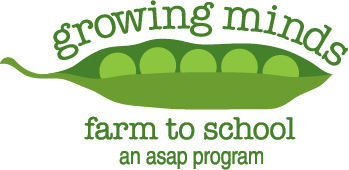This week’s theme is cabbage. Our “Growing Minds Day by Day” educational resource lists are designed for families and educators.
Growing Minds Day by Day
Cabbage
It’s October, and cabbages are the Growing Minds Get Local @ School product of the month! Cabbages are members of the brassica (or cole) plant family, along with their cousins broccoli, kale, cauliflower, bok choy, Brussel sprouts, and more (it’s a big family). They’re cool season veggies that are grown in our mountain region in the spring and fall. Because each head of cabbage is actually a densely packed collection of many cabbage leaves, one head can often be used to make several meals. They’re a budget-friendly and versatile veggie. Cabbages originated in Europe, and they’re used heavily in Russian, Northern European, and Korean cuisines, among others. Try cabbage raw on sandwiches and tacos, or cooked in soups and stews. Fun fact: one cup of shredded raw cabbage contains 190% of the daily recommended amount of vitamin C! Use the resources and recipes below to learn more about cabbage.
Books:
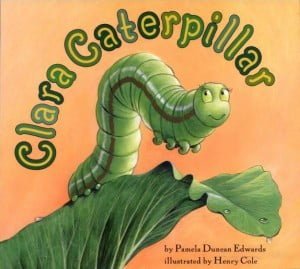 Clara Caterpillar
Clara Caterpillar
If you’ve ever grown cabbages (or any of its cousins), you’ve probably seen little green cabbage caterpillars. This fictional story by Pamela Duncan Edwards tells the tale of Clara, a cute and carefree common cabbage caterpillar who becomes a courageous and completely contented butterfly. Kids love the alliterative language and characters in this great garden adventure. Watch a read aloud on YouTube. Recommended for ages 4-8.
 The Giant Cabbage
The Giant Cabbage
In this Alaskan folktale, Moose chooses his largest cabbage to enter into the Giant Cabbage Contest at the Alaska State Fair, but he’s going to need some help from his friends! An old Russian folktale inspired The Giant Cabbage, but this contemporary version showcases Alaska with vivid illustrations, adorable animal friends, and verbal twists and turns. Watch a read aloud on YouTube. Recommended for ages 3-7, this book contains a recipe for Moose’s Cabbage Soup.
Find more books
Visit the Growing Minds’ farm to school literature database to discover more of our favorite children’s books about cabbages and other veggies. Type “diversity” into the search bar to find books that feature characters from underrepresented racial and ethnic groups.
Local Food Recipe:
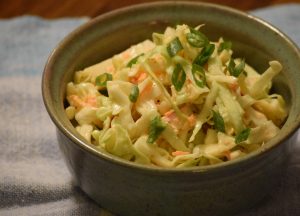 This simple recipe features two fall favorites: cabbage and apples, plus a creamy, tangy dressing. Be sure to let kids help prepare this dish. You can use our printable Kids Cooking Bingo card to track their culinary achievements. Kids can… grate the carrot and apple, use a kid-safe knife to shred the cabbage, and measure and mix together the dressing.
This simple recipe features two fall favorites: cabbage and apples, plus a creamy, tangy dressing. Be sure to let kids help prepare this dish. You can use our printable Kids Cooking Bingo card to track their culinary achievements. Kids can… grate the carrot and apple, use a kid-safe knife to shred the cabbage, and measure and mix together the dressing.
Apple Coleslaw
Serves 3-4
Ingredients:
- 1/2 medium head of local cabbage, shredded
- 1 small carrot, grated
- 1 small apple, grated
- 1/4 cup mayonnaise or plain yogurt
- 1 tsp. lemon juice
- Salt and pepper
Directions:
- Mix cabbage, carrot, and apples in a large bowl.
- Whisk lemon juice and mayonnaise (or yogurt) together.
- Toss all ingredients until thoroughly mixed. Add salt and pepper to taste. Enjoy!
Educational Resources:
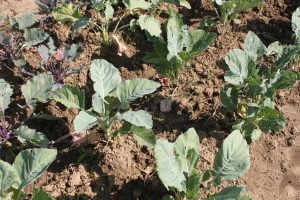 Growing Minds Lesson Plans
Growing Minds Lesson Plans
- Cabbage Exploration (Preschool): Children gain confidence in trying new foods and become familiar with a new vegetable. Through a hands-on activity, children explore a new vegetable and taste two varieties of cabbage.
- Cooking Play (Preschool): Children learn about a variety of cooking tools including plastic knives, measuring spoons and cups, whisks and mixing spoons. Through a fun, dynamic learning environment children explore how to use the tools successfully.
- Vegetable Castles (Preschool): Children become comfortable with tasting new foods in the supportive, positive environment of their preschool. Children learn about and learn to identify different types of local fruits and vegetables.
- Cabbage Exploration (K-2): Introduce students to cabbage and guide them in closely observing characteristics of, and tasting, several cabbage varieties.
- Cabbage Quesadillas (K-2): This lesson plan has step by step instructions for cooking in the classroom and features literature and curriculum connections. The recipe requires heat and features local cabbage and apples.
- Veggie Crowns (K-2): Introduce students to new fruits and vegetables.
- Harvesting the Garden (K-2): Students will review characteristics of mature produce and learn how to harvest different types of fruits and vegetables. As a class, students will make harvesting calendars and apply their harvesting skills in the garden.
- Eating in Season (3-5): Guide students in using scientific inquiry to design a seasonal taste test and investigate what produce is grown nearby seasonally, if locally grown foods tastes better, and what other factors might play a role in flavor. Groups will graph and summarize results and the class has the opportunity to discuss benefits of seasonal meal planning and eating locally grown products.
Video: Cooking Cabbage Apple Quesadillas
Educators can use this video as a tool to learn tips for conducting classroom cooking demonstrations. Kindergarten students from Cullowhee Valley Elementary School cook apple cabbage quesadillas with help from Western Carolina University pre-service teachers and dietitians through ASAP’s Growing Minds Farm to School Cooking Program.
More resources
View additional cabbage-themed resources here.
Activities:
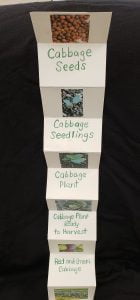 Make a Cabbage Accordion Book: This is a sequencing activity. Have children seen cabbage growing? Show the children photographs of cabbages at different stages of growth. Ask children to order and glue the pictures from beginning to end of a cabbage’s growth in accordion books. They can glue the extra pictures in the cover or on the back pages of the book.
Make a Cabbage Accordion Book: This is a sequencing activity. Have children seen cabbage growing? Show the children photographs of cabbages at different stages of growth. Ask children to order and glue the pictures from beginning to end of a cabbage’s growth in accordion books. They can glue the extra pictures in the cover or on the back pages of the book.
Cabbage Graph: Give children samples of different cabbages (red, green, Napa) to taste and explore, then vote on the class favorite. Make a graph of the results.
Cabbage Examination: Bring in several different sized cabbages. Pass them around and ask the children to guess their weight. Weigh the cabbages and see how close the children came to the correct weight. Let the children take apart the cabbages and “cook” with them at their play kitchen station.
Cabbage Family Tree: Cabbage has a large extended family that includes broccoli, cauliflower, brussels sprouts, and kale. Create a collage with images of all these vegetables and then make a cabbage family tree.
Food Coloring Science Experiment: Add some color to your home with an activity that will amaze your children as much as it will teach them. Take a few clear glasses and fill them halfway with water. Have the kids pick out their favorite colors and, using a few drops of food coloring, color each glass of water with a different color. Leave one glass with plain water. In each glass, place a green cabbage leaf (this activity can also be done with white flowers or celery stalks). Over the next few days, watch how the leaves change color as they soak up the water in the glass. Explain to your children that plants need water to grow and survive, just like we do. You can also experiment with splitting the stems in half vertically and dipping each half in different colors. This will produce flowers with petals that are two colors.
Moose’s Cabbage Soup + Giant Cabbages:
Celebrate the culmination of cabbage week and the beginning of Fall by making a batch of Moose’s Cabbage Soup. This recipe was adapted from the book The Giant Cabbage, in which Moose grows a giant cabbage to take to the fair, but finds it is too big to move! With the help of his friends, he finally succeeds and makes a giant pot of this delicious soup to share.
Before you start making your soup, watch a short video about a real-life giant cabbage farmer in Alaska, and meet the Cabbage Fairies who bring a little magic to the annual Giant Cabbage Weigh-Off!
Moose’s Cabbage Soup
Serves 4-6
Ingredients:
- 6 cups vegetable broth
- 2 Tbsp. unsalted butter
- 1 large onion, diced
- 1 garlic clove, minced
- 1 1/2 lbs. unpeeled potatoes, scrubbed and cubed
- 3-4 carrots, chopped
- 1/2 large head of local cabbage, chopped
- 1 tsp. each of dried parsley and oregano
- Salt and pepper
- Water
Directions:
- Pour broth into a slow cooker.
- In a frying pan, melt butter and sauté onions until golden. Add to the slow cooker.
- Add remaining ingredients and cover with water or additional broth.
- Cook on low setting, until the potatoes are tender.
- Add salt and pepper to taste before serving. Enjoy!
—
That’s it for this week. Check back next week for new resources. Click here to access Day by Day resources from past weeks. If you didn’t find what you’re looking for here, please visit our Lesson Plans page.
